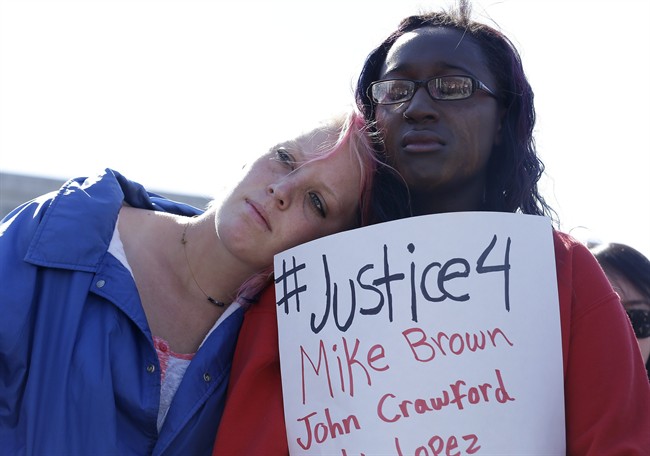TORONTO – One of the main factors that’s come out in the grand jury’s decision not to indict Officer Darren Wilson is the conflicting witness accounts in the altercation that ended in the Ferguson police officer shooting 18-year-old Michael Brown, a phenomenon psychology experts say is common.

Prosecuting Attorney Bob McCulloch said there were inconsistencies and erroneous accounts from witnesses. When asked by a reporter whether any of the accounts amount to perjury, he said, “I think they truly believe that’s what they saw, but they didn’t.”
READ MORE: Highlights of testimony in the Michael Brown shooting
Inconsistencies included one witness who said Brown never raised his hands in the air in an act of surrender and ran towards Wilson “full charge” as compared with another who testified Brown didn’t advance toward Wilson in a threatening manner, but looked “stunned.”
Maxwell Gwynn, an assistant professor in Wilfrid Laurier University’s department of psychology, researches eyewitness testimony. He says such testimony isn’t nearly as reliable as we think.
“Eyewitnesses will often ‘fill in the blanks’ in their incomplete memory when encoding, storing, and retrieving their memory of a face,” Gwynn wrote in an email to Global News, noting there are many factors at play.
- Gas station clerk stabbed several times during violent attack at Ultramar in Montreal
- Man acquitted in Tina Fontaine murder found dead, says her aunt
- Cars torched, explosions heard in suspected arson in Montreal neighbourhood
- Canadians should expect politicians to support right to bail, Virani’s office says
- Weapon focus effect – Gwynn says this describes the problem of being less able to subsequently identify a face when there is a weapon visible, “as attention and cognitive resources are drawn away from the perpetrator’s face towards the weapon itself.”
- Cross-race effect – Witnesses remember the faces of people of their own race better than they do faces of people of different races, says Gwynn, suggesting people may have less experience with people of other races versus their own.
- Expectations, preconceptions, and cultural stereotypes can also reduce eyewitness accuracy.
Besides these factors, University of British Columbia forensic psychologist Dr. Stephen Porter says “memory contamination” is even more problematic. This happens after the event due to improper and/or leading questioning by police, family members or even talking with other witnesses, he says.
Porter says he’s found that more than 70 per cent of people can be led to remember entire crimes that did not actually occur with repeated misleading questions in his own research.
Gwynn also pointed to a famous 1947 psychology study in which people were shown a hand drawing of people in the New York subway, including a well-dressed African American man and an older, shorter Caucasian man dressed in blue-collar clothing. The white man holds a straight razor and gestures towards the black male in the drawing, said Gwynn.
Participants briefly looked at the drawing then had to describe it to another person, who described it to another and so on through about five other people. In more than half of the final descriptions, participants had reversed the situation to describe the black man as the one holding the razor and acting in a threatening manner towards the white man.
“This sort of description was provided even among ‘witnesses’ who held no anti-African American bias. The researchers concluded that cultural stereotypes and expectations (which in the 1940’s may have included blacks as being more aggressive and likely armed), may have influenced the reports provided of the scene,” said Gwynn.
“The mind is not like a videotape machine, faithfully encoding, retaining, and retrieval visual images. Information obtained after the original event (such as seeing mug shots of potential suspects or reading about descriptions of the perpetrator in the paper), may result in faulty retention or retrieval of the face from memory,” he said.
“The end result is that people tend to overestimate their ability to describe or correctly recognize a perpetrator or the events of an often traumatic and arousal-invoking incident.”
Porter said conflicting testimony, such as that in Brown’s case in Ferguson, is due to each person’s unique experience, including biases that affected their perception of the event, differing stress levels during the incident and different questions and misinformation afterwards.
“For example, one witness could be interviewed by a police investigator who uses a large number of leading questions and suggestive techniques to help him/her ‘recall’ the incident. Another might be allowed to tell his/her story uninterrupted and then appropriately asked non-leading open-ended questions as follow-up. We would expect the stories and accuracy of these two witnesses to be dramatically different.”
Gwynn added a confident witness may not be any more accurate than a non-confident witness, which can affect the legal proceedings.
“This is a particular problem in that jurors or other triers-of-fact are more influenced by and put more faith in the testimony of a confident versus non-confident witness; this may be misplaced faith.”


Comments